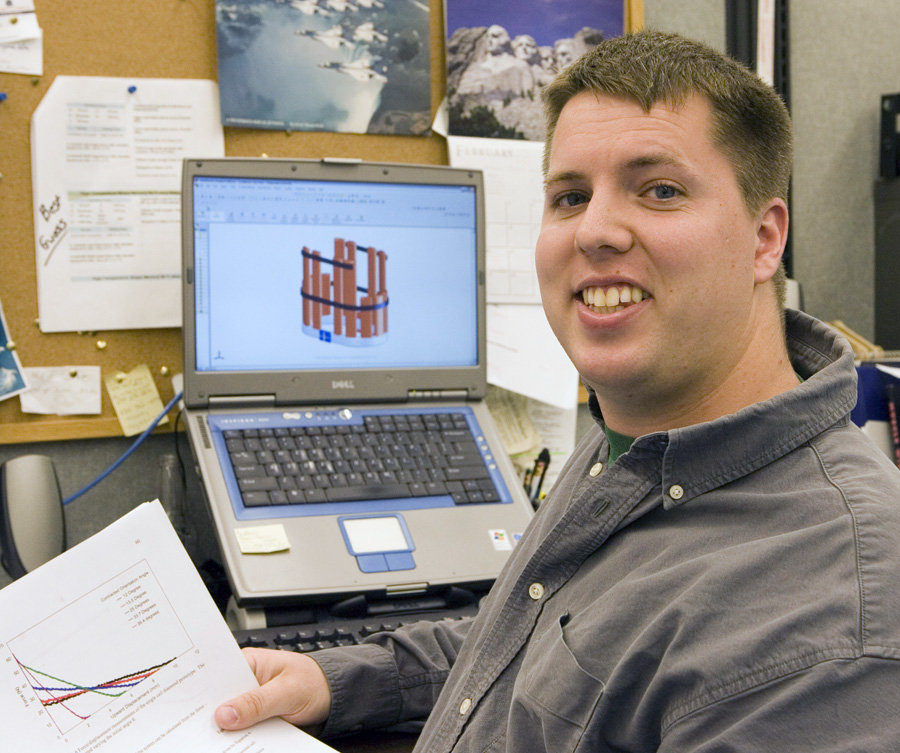March 2, 2006 — When Adam Malcom sat down to design a new life jacket, the University of Virginia mechanical engineering student asked himself a simple question: what would he be willing to wear?
His answer — a slender belt from which a series of inflatable bladders deploy when necessary — was the winner of an international competition sponsored by Boat U.S. Foundation for Boating Safety and the Personal Flotation Device Manufacturers Association.
Malcom’s design was chosen from among 182 entries submitted by both individuals and companies. He received the prize which included a $5,000 cash award at the Miami International Boat Show, the largest show of its kind in the world, on Feb. 16.
Growing up in northwest Ohio, Malcom and his family spent considerable time boating on Lake Erie, and his passion for boating has continued. He currently owns his own 14-foot aluminum fishing boat as well a 24-foot Chaparral cabin cruiser. Most recently, he and a fellow U.Va. student recently co-purchased a 20-foot Mirage Sloop, which they sailed on nearby Lake Anna in the fall but have recently sold.
But for Malcom, 25, those traditional, bulky orange life vests have always been a bother to wear. And he’s not alone. Coast Guard studies indicate that boaters’ failure to wear life vests is the cause of as many as 400 deaths a year.
“My parents made us wear life vests when we were kids,” he says. “Once I got my own boat, though, I rarely wore one. They’re uncomfortable, extremely hot, dorky-looking, and significantly lack maneuverability.”
With that in mind, Malcom imagined a device that would exhibit the opposite characteristics — comfort and maneuverability in addition to being unobtrusive and reliable.
His winning design is a slender belt in which a CO2 gas cylinder inflates 16 stored air bladders that emerge from the belt. The blaze-orange bladders are arranged symmetrically around the belt and unfurl much like party favors, rising from the belt to surround the wearer under the arms and providing buoyant support. Other devices lash the bladders into place around the user.
“There are two ways to trigger the bladders,” Malcom explains. “One is manually with a rip cord; the other is with a pressure-operated sensor already in existence that will activate the CO2 cylinders when the user is fully submerged in the water. This is vital for those that might potentially fall into the water, unconscious, due to an accident.”
Malcom admitted that the weakest part of his entry was the lack of precise cost estimates. The goal was to keep the retail cost below $30. Malcom estimates that it would cost a bit more to create a prototype but thinks the price would be affordable in mass production. “The cost per item is highly dependent upon how many units are produced and what materials are used. I want to make this product extremely reliable, but equally want people to be able to afford to purchase it,” Malcom says.
Back in his lab in Charlottesville, Malcom has begun the process of filing a provisional patent for his device. In addition, current plans include the creation of a working prototype and a market study.
“The biggest obstacle to taking this from drawings to a real product that will meet the criteria necessary for Coast Guard approval,” Malcom says, citing testing that judge material quality, adequate buoyant support, and reliability.
Even without that approval, he notes, the device could still be used by boaters as well as others including snorkelers and scuba divers. “It is far better to have any type of device capable of providing buoyant support, when needed, than to have nothing at all,” he says.
Malcom, who received his undergraduate degree from the University of Toledo, will earn his master’s degree in mechanical and aerospace engineering from U.Va.’s School of Engineering and Applied Science in May.
Founded in 1836, the University of Virginia School of Engineering and Applied Science combines research and educational opportunities at the undergraduate and graduate levels. Within the undergraduate programs, courses in engineering, ethics, mathematics, the sciences and the humanities are available to build a strong foundation for careers in engineering and other professions. Its abundant research opportunities complement the curriculum and educate young men and women to become thoughtful leaders in technology and society. At the graduate level, the Engineering School collaborates with the University's highly ranked medical and business schools on interdisciplinary research projects and entrepreneurial initiatives. With a distinguished faculty and a student body of 2,000 undergraduates and 650 graduate students, the Engineering School offers an array of engineering disciplines, including cutting-edge research programs in computer and information science and engineering, bioengineering, and nanotechnology.
Media Contact
Article Information
March 2, 2006
/content/university-virginia-engineering-student-wins-international-competition-life-jacket-design

